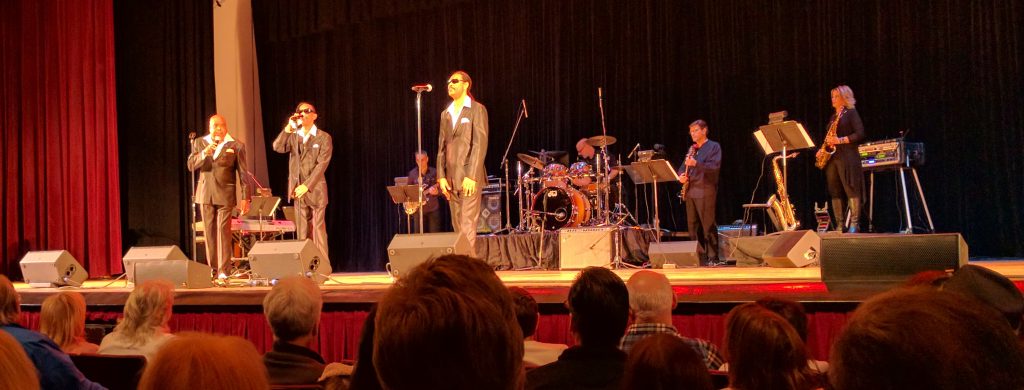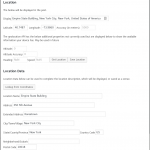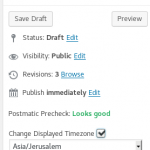IndiewebPress: Users
In the Indieweb world, your domain is your identity. This would suggest that most WordPress sites should only have one user…representing the identity of the site. Users, however, represent roles and responsibilities within the system, not necessarily content creators.
In an update to the ‘official’ Indieweb plugin, I, with some encouragement, added the idea of designating a specific user as the ‘identity’ of the site…assuming there was one. But let’s expand that idea a bit. We have user metadata, we have the ability to define new roles and capabilities. So, what can we do with this but create new possibilities? We can better work what a role is, and add additional properties and behavior to improve the system.
There is a setting for an admin email, for which the suggestion to expand outward has been proposed for 8 years in this vein. This should be a property of any administrative account.
I have an idea I’ve long wanted to implement. It is based on a feature used by Postmatic. People who subscribed to the email service they provided would end up as users on your site. I’d like to see enhancements to the user profile. When trying to add other site profiles to user metadata, I discovered that this being left to the plugins has resulted in a complete lack of consistency.
There needs to be a consistent structure to add data to support URLs on specific other types of sites( for example, Twitter), or every plugin is going to have to retread this. This is the trouble we have with all metadata unfortunately.
That idea of using the user table for outside visitors has a lot of good potential. Commenters could create a profile on your site that could be imported from elsewhere…namely your own website. There is a certain level of trust there, because you would be displaying images and text about a person from another site…however, that is what gravatar does. Why not allow people to do it from their own site?
Gravatar itself is something that WordPress wouldn’t have put in today….a reliance on an outside service. The local avatar trac ticket is also a rather old request. It is time to look at avatars in general…to build a robust local system that is enhanced by gravatar…gravatar should not be that system. We can add in modern themeable profiles for users, as opposed to just archive pages. We can make a much better system for users.
The whole point of the ‘subscriber’ role in WordPress is for people not part of the blog to have an account they can do something with…follow the site, get updates, participate in comments…but this part of WordPress is woefully underused.
IndiewebPress: Connecting Your Site and Mine
In the previous article, I discussed my thoughts on the subject of comments as a structure and what comments could be capable of if that structure was improved. But, when I showed that to several people, the comment was, quite legitimately, that I didn’t explain what could be built on top of that. I had another topic in mind before covering this, but that made me want to document this as well.
Let’s start with webmentions. Webmentions builds on the idea of the two protocols that are built into WordPress: Pingbacks and Trackbacks. Trackbacks have to be discarded from WordPress. There is no verification of them…it is basically letting anyone post something on your site…moderated or not. The other site tells you they’ve linked to you(even if they haven’t) and what to make it look like on your site. And because of this…while I’ve tried to think of ways to save it, I think it needs to, over time, go on the chopping block.
Pingbacks, despite actually verifying that a URL links to where it says it does, currently don’t do anything else interesting in WordPress. The appearance and usage has stagnated. It could be improved on the display side, and I’ve tried to get interest in that…but I’m wondering as we move forward…considering the legacy design issues, the bad feelings, what I would like to see happen with comments, etc…if we should just let Pingbacks stay where they are with only some performance and other minor refinements, and develop Webmentions.
Webmentions have advantages. They support update and delete functionality if the source changes in the future. They have a standard recommended by the W3C(which the previously implemented protocols do not), as well as a dedicated community who has implemented them on their sites.
What was never realized in potential by previous protocols, but Indieweb community members are implementing is the magic. Someone links to your site with a post on their site. They use webmention to tell you that they linked to you. But what your site does at that point is controlled by you. You can parse their post and display it as a comment, or based on how their page is marked up, derive other meaning and relationships from it. You can just use it in a simple counter or stat display to note how many people linked to you. There have been some fun discussions of using it to share bibliographic data.
If you had to pick one thing, webmention is the key building block on which the Indieweb is built. By itself, it requires no trust on the part of the receiver. There is a developing extension called Vouch which allows the sender to provide proof that someone the receiver knows trusts them. And, moderation aside, presentation of this is wholly left to the receiving site. Back to the comment point in the previous article on this, one of the functional WordPress problems is that there is no way for a plugin to declare a custom comment type and tell the theme how to display it or whether to display it at all. You effectively have to hijack the comment template to do this, instead of working with it.
To the point of something like annotations, the idea of fragmentions which allow a specific part of a post to be referenced more effectively…WordPress doesn’t support inline comments of any type or marginalia. There is a trac ticket to implement the W3C’s work on annotations, but WordPress has nothing to allow for displaying this sort of work.
There is a current Webmentions plugin for WordPress that is under continual development. It was created by Matthias Pfefferle, and I have been a regular contributor to it. It handles the functional plumbing of webmentions, but not the improved display aspect. That has been delegated by its creator to a second plugin, Semantic Linkbacks, which attempts to offer the parsing of external sites and deriving information like author(name and photo), etc.
It is worth trying the combination of these. But there is more that can be done here as well. Cover more types, improve the ability to store commenter’s data, etc.
IndiewebPress: Improving Comments
Comments in WordPress were originally thought of as a way for visitors to a site to have discussions on the site. I’m going to refer to the traditional comment idea as ‘local comments‘. This is where someone fills out a comment form on a post, which adds a comment to the page, either with or without moderation.
Also built-in to WordPress are pingbacks and trackbacks. These are where another site notifies of a link to the page and this is displayed as a comment on the page. Pingbacks and trackbacks have their issues, and admittedly, WordPress, except for some minor tweaks, has left the presentation and features of these mostly unchanged, save for some security efforts. Therefore, it has become common to disable them. Webmentions are a replacement for the older pingback and trackback protocols.
There are also custom comment types used for things like logs, receipts(See mention in Trac Ticket which notes that popular plugin Easy Digital Downloads does this), etc. which are not part of the general vision of what a comment is. Of course, custom post types aren’t all traditional posts either.
Meanwhile, other areas of WordPress are getting functions to register functionality. 1n December of 2015, a ticket was opened for Custom Comment Types. This would, in theory, mirror the functionality of Custom Post Types, where a registration function would declare the functionality and behavior of a comment type.
But there are issues here beyond what is identified in the ticket. How will a theme know how to display the new comment type? There needs to be a way for this to be specified by the registration and overridden by themes that know what that comment type is. There is a possibility there may be some breaking changes in that design.
Meanwhile, comments cannot be referenced uniquely and distinctly. There is another ticket equally old, proposing comment permalinks. Whether this is just to find the comment on whatever page it is on, or allowing a comment template that emphasizes the comment by itself, it is an aspect of the comment system that needs replacing.
That addresses the structure, but not what could be done with it. Not only would this allow for webmentions as a medium to create comments(webmentions being the successor to pingbacks), but support for responses that are popularly used today such as like, emoji, annotation, etc. The Semantic Linkbacks plugin tries to create these relationships in comment meta, but it is not as robust as a supported implementation would be.
Annotations and marginalia recently have been of interest in allowing people not to just comment on a post as a whole, but on specific areas of it. This could also be a promising piece of a comment overhaul…supporting this. In my contributions to the Webmentions plugin, I started this by supporting URL fragments(see fragmentions), which would allow for a specific part of the post to be highlighted.
Thinking about Mary Tyler Moore
I’ve been a fan of Mary Tyler Moore for a long while. The Dick Van Dyke show, where she was a supporting character, and the Mary Tyler Moore show where she starred. I even remember her appearance on Shalom Sesame, which I found this Youtube clip of.
The laughs aside, the thing that stays with me out of her body of work the most is the end of the Mary Tyler Moore show. In the show, a new manager has arrived and wants to do something about the low ratings of the news program the characters produce. He fires the production staff, but keeps the on-air talent…a well meaning type known for flubbing his lines. The same individual tries to write his own goodbye to his friends, deciding that the right words are, for reasons unknown, “It’s a Long Way to Tipperary, it’s a long way to go.”
The scene is one of the most memorable in TV history, with Mary’s character expressing that a group of people who work together, who spend time together…become like your family. Despite all of the sadness in the scene, the characters leave their office…their home away from home…for the last time, heads held high, singing. There is a lesson in that scene that resonated with me.
It’s a long way to Tipperary. It’s a long way to go.
After three days, I have given up on directory by genre and am going solely with artist. Meanwhile, I am still trying to fix the genre settings for music players that use them. Allan Sherman is not genre Christmas. The Beatles are not Data. Someone contributed this data to a service. I’m not sure if they were not messing with me.
I have organized much of the files, but it looks like I’ll have to do an audit of all music I backed up from CD, because the auto-organizing tools seem to have reclassified a lot of material. But, for now, I’m pausing with forty-nine gigabytes worth of MP3s and a lot more tagging. Organization is frustrating.
My 2017-01-01 Commitment – Location Support Returns
This post, for example, is set as if it was made at the Empire State Building.
Coming in the future is venue support. A venue is sort of the location equivalent of a bookmark. There are other names for it. It would allow more information about the location, and you would be able to view all posts associated with that location. This leads to what has become common on social media sites…the check-in. I used to store more information about the location in the post, and won’t be doing this anymore.
More to come on location and more, but I’m glad I got a version of this out. Thanks to Chris Aldrich for testing this out.
 Welcoming in the New Year with the crew and passengers of JetBlue flight 1472 bound for New York.
Welcoming in the New Year with the crew and passengers of JetBlue flight 1472 bound for New York.Music video for “Hasmonean”; a parody of Hamilton,; originally by Lin-Manuel Miranda
Winter Doo Wop Explosion
- The Jarmels
- Kid Kyle
- Barbara Harris and The Toys
- Vito Picone and The Elegants
- Jay Siegel’s Tokens
- Cancelled: Lenny Dell and The Demensions
I’ve been a fan of 50s music since I became fond of the classic movie, Back to the Future, as a child, and came to listen to a lot of music from that era.

The audience was also from that era. The majority of people there were of an older bent. The Jarmels were only 33% original, and 66% replacement. But I am always struck by the performances by doo wop groups, and what they do with their hands and feet while performing…something you can’t hear in the recording. The Jarmels only had one hit, A Little Bit of Soap.
Kid Kyle was one of the youngest people there, except me. Of course, he got paid. He’s just under 22 and has been singing doo-wop since he was 8. It is nice to see that these songs will not die with their originators and original fans.
The Toys were formed in 1961 in Jamaica, Queens. Barbara Harris, the lead singer of the Toys, is still actively touring with two younger musicians. While it was my least favorite act, mostly because I found the pitch painful because I was too close to the right speaker( 5 rows from the front), Harris was impressive in the energy she is still able to convey. She had several Senior Citizens dancing in the aisles.
The Elegants also only had a single hit…Little Star, which Vito Picone recorded when he was 17. Now 75, he and the remaining Elegants performed not only that song, but a doo-wop cover of Ray Charles’ Georgia(Picone oddly put on dark sunglasses for that), as well as several other songs.

Finally, the Tokens appeared. Out of these groups, I had seen the Tokens perform before. Their version of The Lion Sleeps Tonight, with Jay Siegel still able to hit the high notes he hit in 1961 is still impressive, and despite other recordings predating it, is generally the best known version of the song.
The group started in Brooklyn, and Neil Sedaka was one of its early members. The Tokens also produced other musical acts, such as the Chiffons, Randy and the Rainbows, the Happenings, etc.
For anyone interested in their next concert, the same production group is bringing Vito Picone back, along with the Happenings, the Marcels, The Tymes, and The Excellents on Saturday, March 25th, 2017 at 7:30PM, also at the Colden Auditorium at Queens College. Call 718-423-8394 for more information.
The event was also the first I brought my new 360 degree camera to. It is interesting to take a video where you can see not only the audience, the performers…but me reacting to them. That’s a bit too much me in the shot. I like a bit more subtlety.
But there is some part of me that wishes random people still formed doo-wop groups. Part of me would enjoy the experience of singing with one at least once.
CBS’s Elementary Gets Kosher Wrong
The episode that aired last night, entitled, How the Sausage is Made…has Sherlock Holmes coming up with a conspiracy where there is a enough profit in the FDA classifying artificially grown meat as a ‘meat substitute’ instead of as meat to allow Jews to eat cheeseburgers and Muslims to eat pork that someone would kill to ensure it.
During the course of the episode, Holmes tries to explain kosher law, among other things….that food is broken out into meat and dairy, and a third category that is neither…one he calls Parevah. I usually say Pareve, but even par-veh is correct. I’ve never heard anyone call it pareva, to be honest and I asked around this evening. There isn’t one person who could look up the common pronunciation. One would assume the character might be wrong, but in the scene he had just met with some rabbis discussing the issue, so he should have just heard it. On the other hand, if you google pareve, and click the pronounciation, it pronounces it paravah also, I embedded Google’s pronunciation below. Either someone tell me they’ve heard it pronounced as three syllables or someone at Google please correct it.
Perhaps in a universe where the Convocation of Orthodox Rabbis(I’m assuming as a stand-in for the OU, the Orthodox Union) exists, the issues are different. I confess to not be as familiar with the Halal certification bodies in the U.S. but I am fairly familiar with the kosher ones.
So in the end, Holmes and Watson lead the murderers to believe that the bodies that certify kosher and halal food will, because of the suspicious murder, never certify the artificial meat as ‘pareva'(sorry, it just annoys me) and that the whole murder would therefore be pointless as the product would be relegated to the vegan aisle. And if someone confeeses to the murder, the rabbis and the imams will change their mind because ‘murder is not kosher.’ I would hope that the two characters are lying through their teeth, but I would hope that two individuals who are counting on a big payday from kosher and halal sales would know better the issue if they are going to kill for it.
The truth of the matter is that the issue of whether meat grown in a lab would be considered not to be meat, and thus not subject to the prohibitions of keeping meat and dairy separate is not an issue so clear cut for many reasons, so it would not be something that they would hold over the heads of would-be murderers like a business transaction. If you just search for kosher artificially grown meat, the first few entries lay out how much debate would be necessary to settle the issue. And in my personal opinion, it is much more likely to be classified as meat.
That said, the suggestion that all Jews are sitting around, clamoring for the opportunity to find a loophole to eat cheeseburgers and other food which is not kosher(the same for Muslims) suggests an extreme level of cynicism.
I have to say, while television is often lacking in realism, and often poorly written, this seems to be a case of a writer trying to come up with a clever story, but failing to do five seconds of research to put the issue into a realistic perspective. And, while poor characterizations of Jews on television has always annoyed me, sloppy storytelling annoys me even more.


















